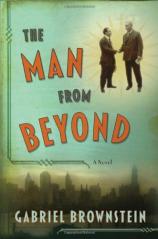The Man From Beyond
Review
The Man From Beyond
Molly Goodman, the protagonist of Gabriel Brownstein's first novel,
is something of a prototype for the future. THE MAN FROM BEYOND
takes place in the early 1920s during the postwar period. Molly is
an independent woman working as a reporter for a New York tabloid
and living with a roommate from Vassar. She smokes --- and not just
tobacco --- and maybe is a little in love with her aforesaid
roommate.
Molly starts off as a cosmetology reporter ("it's sort of a
science," her editor explains to her), but ends up with a job
that's very twenty-first century. She's the "personalities"
reporter, reporting on celebrities in an era before there really
were celebrities.
In her era, of course, Molly can't follow around brainless
starlets, lip-synching nonentities or superannuated child actors.
She has to report on celebrities from the past, and in that, Molly
is more fortunate than those who have followed her into the
profession.
First there is Sir Arthur Conan Doyle, author of the Sherlock
Holmes stories. Here, Conan Doyle is close to the end of his
string, mourning the loss of his son in the Great War and fully
enthralled in the clutches of that new religion,
Spiritualism.
His friend Harry Houdini is deeply into middle age here, but can
still amaze with his dexterity, particularly when it comes to
handcuffs and the tools of the escapist trade. Sadly, Houdini may
be less known than Conan Doyle nowadays. Outside of the admiring
mention he gets in Michael Chabon's THE AMAZING ADVENTURES OF
KAVALIER AND CLAY, you might not have heard his name in the last
ten years.
In THE MAN FROM BEYOND, Houdini has branched out into movies (the
book shares its title with one of Houdini's silent films) and is
into debunking the myth of Spiritualism. As Conan Doyle is the
great scientific defender of Spiritualism, completely convinced of
its tenets, this puts him into direct conflict with Houdini --- and
this conflict is what drives THE MAN FROM BEYOND.
The scenes in the book where Conan Doyle matches wits with Houdini
--- at séances and "spiritual writing" sessions --- are the
heart of the tale. Houdini has too much respect --- real or feigned
--- for Conan Doyle to take him on directly, and so he fights back
against him in the press. This is where Molly Goodman comes in, as
both Conan Doyle and Houdini use her to talk to each other in much
the same way that children who aren't talking to each other utilize
their parents.
There's a grand aura of mystery around both Houdini and the creator
of Sherlock Holmes, and Brownstein is wise not to disturb that too
much. Instead, he concentrates on the character of Molly Goodman,
celebrity reporter, and brings us into her interior life.
Unfortunately there isn't anything truly compelling or interesting
about Molly, especially compared to Houdini and Conan Doyle. Even
her (impressively) stereotypical Jewish parents are more
interesting, more alive in some ways, than Molly manages to be. Her
actions, reporting, and even sexual experiences seem to be in the
passive voice; things happen to her instead of the other way
around.
Nevertheless, THE MAN FROM BEYOND is a good read, and the conflict
between Conan Doyle and Houdini is still an important one.
Brownstein does an admirable job of bringing the period in between
the wars back to vivid life. But there's a reason why people read
about celebrities and not about celebrity reporters.
Reviewed by Curtis Edmonds, who writes movie on January 7, 2011
The Man From Beyond
- Publication Date: September 12, 2005
- Genres: Fiction
- Hardcover: 320 pages
- Publisher: W. W. Norton
- ISBN-10: 0393051528
- ISBN-13: 9780393051520




